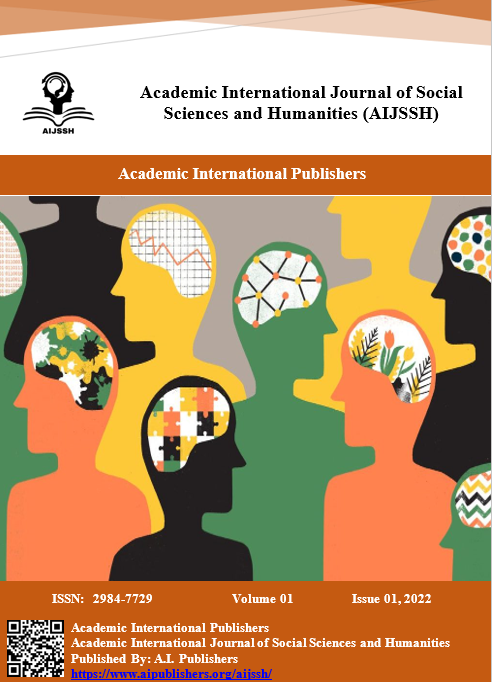Psychometric Properties of the Arabic version of Organizational Commitment Questionnaire-Revised (OCQ-R) in Educational Settings
DOI:
https://doi.org/10.59675/S221Keywords:
Commitment, Loyalty, Organization, Workplace, EmploymentAbstract
The purpose of this study was to examine the psychometric properties of the Organizational Commitment Questionnaire (OCQ, Revised Version of Meyer, Allen & Smith, 1993) in the Iraqi cultural context. The translation and adaptation process involved forward and backward translation of the OCQ-R. A pilot study was conducted on a sample of 42 teachers to test the cross-language validity of the English and Arabic versions of the OCQ, and a significant correlation (r=.722, p<.000) was found between the original and adapted versions of the OCQ-R. In the next step, the Arabic version of the OCQ-R was administered to a sample of 302 teachers from schools of Kerbala, Iraq, with an age range of 25-51 years (M=38.5 & SD=6.12). The reliability of the OCQ-R was established through Cronbach’s Alpha=.84, on a sample of 302 teachers. The results indicated that the Arabic version of the OCQ-R is a reliable instrument for assessing teacher’s organizational commitment in the Iraqi culture
References
Allen, N. J., & Meyer, J. P. (1990). Organizational socialization tactics: A longitudinal analysis of links to newcomers' commitment and role orientation. Academy of management journal, 33(4), 847-858. http://dx.doi.org/10.2307/256294 DOI: https://doi.org/10.5465/256294
Allen, N. J., & Meyer, J. P. (1993). Organizational commitment: evidence of career stage effects?. Journal of business research, 26(1), 49-61. http://dx.doi.org/10.1016/0148-2963(93)90042-N DOI: https://doi.org/10.1016/0148-2963(93)90042-N
Allen, N. J., & Meyer, J. P. (1996). Affective, continuance, and normative commitment to the organization: An examination of construct validity. Journal of vocational behavior, 49(3), 252-276. http://dx.doi.org/10.1006/jvbe.1996.0043 DOI: https://doi.org/10.1006/jvbe.1996.0043
Alutto, J. A., Hrebiniak, L. G., & Alonso, R. C. (1973). On operationalizing the concept of commitment. Social Forces, 51(4), 448-454. http://dx.doi.org/10.2307/2576690 DOI: https://doi.org/10.1093/sf/51.4.448
Appelbaum, S. H., Audet, L., & Miller, J. C. (2003). Gender and leadership? Leadership and gender? A journey through the landscape of theories. Leadership & Organization Development Journal, 24(1), 43-51. http://dx.doi.org/10.1108/01437730310457320 DOI: https://doi.org/10.1108/01437730310457320
Bashir, N., & Long, C. S. (2015). The relationship between training and organizational commitment among academicians in Malaysia. Journal of Management Development, 34(10), 1227-1245. http://dx.doi.org/10.1108/JMD-01-2015-0008 DOI: https://doi.org/10.1108/JMD-01-2015-0008
Cohen, A. (2003). Multiple commitments in the workplace: An integrative approach. Psychology Press. DOI: https://doi.org/10.4324/9781410607423
Long, L., Fang, L., & Ling, W. (2002). ORGANIZATIONAL CAREER MANAGEMENT: MEASUREMENT AND ITS EFFECTS ON EMPLOYEES'BEHAVIOR AND FEELING IN CHINA. Acta Psychologica Sinica, 34(01), 98.
McElroy, J. C., Morrow, P. C., Power, M. L., & Iqbal, Z. (1993). Commitment and insurance agents' job perceptions, attitudes, and performance. Journal of Risk and Insurance, 363-384. http://dx.doi.org/10.2307/253034 DOI: https://doi.org/10.2307/253034
Meyer, J. P., & Allen, N. J. (1991). A three-component conceptualization of organizational commitment. Human resource management review, 1(1), 61-89. http://dx.doi.org/10.1016/1053-4822(91)90011-Z DOI: https://doi.org/10.1016/1053-4822(91)90011-Z
Meyer, J. P., & Allen, N. J. (2001). Organizational commitment. Personnel psychology and human resource management: A reader for students and practitioners, 289-342. http://dx.doi.org/10.1002/9781118785317.weom050052 DOI: https://doi.org/10.1002/9781118785317.weom050052
Miller, D., & Lee, J. (2001). The people make the process: commitment to employees, decision making, and performance. Journal of management, 27(2), 163-189. http://dx.doi.org/10.1177/014920630102700203 DOI: https://doi.org/10.1016/S0149-2063(00)00094-5
Ng, T. W., Butts, M. M., Vandenberg, R. J., DeJoy, D. M., & Wilson, M. G. (2006). Effects of management communication, opportunity for learning, and work schedule flexibility on organizational commitment. Journal of Vocational Behavior, 68(3), 474-489. http://dx.doi.org/10.1016/j.jvb.2005.10.004 DOI: https://doi.org/10.1016/j.jvb.2005.10.004
O'Reilly III, C. A., Caldwell, D. F., & Barnett, W. P. (1989). Work group demography, social integration, and turnover. Administrative science quarterly, 21-37. DOI: https://doi.org/10.2307/2392984
Porter, L. W., Steers, R. M., Mowday, R. T., & Boulian, P. V. (1974). Organizational commitment, job satisfaction, and turnover among psychiatric technicians. Journal of applied psychology, 59(5), 603. http://dx.doi.org/10.1037/h0037335 DOI: https://doi.org/10.1037/h0037335
Trimble, J. K. (2018). Perceived authentic leadership and organizational commitment. Our Lady of the Lake University.
Wang, Y., Jiang, N., Zhang, H., & Liu, Z. (2021). Organizational justice, burnout, and turnover intention of social workers in China. Journal of Social Work, 21(3), 456-475. http://dx.doi.org/10.1177/1468017320911347 DOI: https://doi.org/10.1177/1468017320911347
Wells, C. S., & Wollack, J. A. (2003). An instructor’s guide to understanding test reliability. Testing & Evaluation Services University of Wisconsin.
Weng, Q., McElroy, J. C., Morrow, P. C., & Liu, R. (2010). The relationship between career growth and organizational commitment. Journal of vocational behavior, 77(3), 391-400. http://dx.doi.org/10.1016/j.jvb.2010.05.003 DOI: https://doi.org/10.1016/j.jvb.2010.05.003
Downloads
Published
Issue
Section
License
Copyright (c) 2024 Academic International Journal of Social Sciences and Humanities

This work is licensed under a Creative Commons Attribution 4.0 International License.






